| • NOTICE. For more information on a topic, you may click the related footnote number. (Example: [3.]) |
Gould 3D: Could It Work?
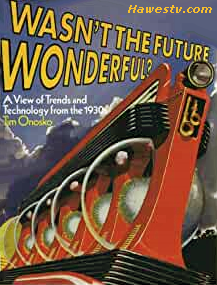
Cover, book on 1930's tech, by late futurist Tim Onosko. [1.] To order: Click photo. |
The late Tim Onosko republished the Gould 3D article from Modern Mechanics and Inventions. [2.] (See Onosko's book Wasn't the Future Wonderful?) Onosko doubts that the Gould 3D television system could have worked. [3.] But perhaps it would have worked. Onosko seems dubious about the use of colored glow tubes at the monitor. The author of this page agrees, to this extent: The idea that the glow lamps could convey naturalistic colors seems questionable, at best. Yet if the cameras had color filters in them, true color might indeed have been possible. In his U.S. patent #2,086,382, Gould mentions the need for two-color video at the monitor inputs. (In other words, the monitor couldn't just “colorize” a black-and-white broadcast.)[4.] |
Two-Color Television. Television with just two (not three) color primaries would have worked just fine. Here are two examples of successful, two-color systems: [5.], [6.] Gould's scanning camera idea is probably sound.
|
|
|
Parallels. There are parallels between Gould's 3D patent and other high-tech equipment that we depend on in today's world. Anyone who has had a CAT scan would recognize the parallels to Gould's 3D television. Or, for more technical readers: Gould's cameras might behave something like a “visual milling machine,” with photoelectric tools. The monitor would replace the tools with kino glow lamps.
|
Onosko doesn't mention the true problem of Gould's two-camera system: The massive moving elements of the camera head. At some boom length, the propellers would become impractical, and even dangerous. Besides, propeller revolutions might interfere with camera-drum rotation. At long boom lengths, the insensitive photoelectric tubes might stop putting out a useful signal. (Gould's invention was ahead of its time. Within just a few years, photomultiplier tubes would take over. They offered a vast improvement in gain.) But remember, Gould also offered the option of one camera without the boom. Maybe that version of his camera head could be practical. Did Gould build a model? If so, what a treasure that would be! Right: Photomultiplier. The tube pins connect to dynodes, the multiplier electrodes. (Stock photo) [7.], [8.] |
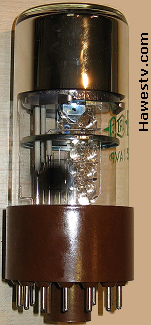
|
Gould's FootstepsIs anyone following in Gould's footsteps today? Yes! A distinguished Japanese team introduced the Seelinder display at the 2005 Siggraph show. This unique display is the brainchild of Tomohiro Yendo, a professor at Nagoya University. Seelinder strongly resembles Gould's monitor. The Seelinder system is a cylindrical display with a revolving parallax barrier. [9.] |
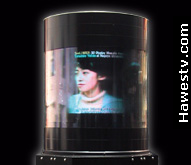 Seelinder display at Siggraph 2005. [12.]
Seelinder display at Siggraph 2005. [12.]
|
Inside the display are concentric drums. (Or cylinders, as the display name suggests.) The outside drum is the parallax barrier. This barrier is about the same as Gould's slotted drum. The barrier only allows the viewer to see one image at a time. The Seelinder's inside drum contains a set of LED arrays that substitute for Gould's neon glow tubes. [10.]
3D without glasses! As with Gould's display, the Seelinder display is autostereographic. That is, no glasses are necessary. The viewer can walk completely around the Seelinder and see the talent from every angle. The Seelinder is a life-size display, in full color. Unfortunately, unlike Gould 3D, Seelinder can only display still images (for now). [11.]
|
In 2010, Sony demonstrated its RayModeler technology, which closely resembles Gould 3D. The RayModeler was on exhibit at the Siggraph exposition that year. The model on display could reproduce 3D cartoons and video games: But not moving live-action figures. Allaying doubts that the Gould cameras would work, Sony has also built such a camera system. So far, the Sony camera system can take live-action stills. The RayModeler monitor can display the resulting 3D views.[13.], [14.] |
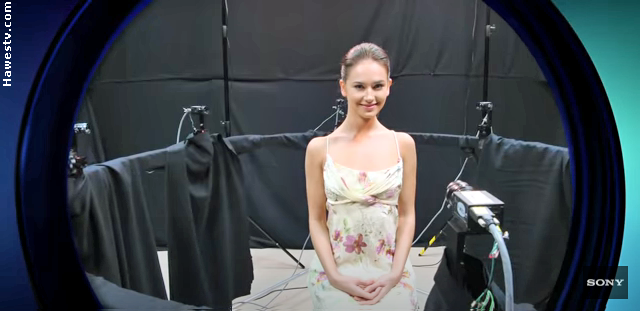 The model is sitting on a turntable inside the Sony RayModeler camera system. On the
outside of the turntable, eight still cameras photograph from different
angles.[15.]
The model is sitting on a turntable inside the Sony RayModeler camera system. On the
outside of the turntable, eight still cameras photograph from different
angles.[15.]
|
Electronic Version of Gould 3D
What about an electronic version of Gould 3D? Would Gould 3D be possible with electronic television? Likely Yes. (The author admits that he's speculating.)
Cameras. For example, each of the Gould cameras scanned a complete frame (one revolution of the cylindrical picture) for every six drum revolutions. That fact suggests that maybe six cameras could cover the picture's cylindrical area. (Imagine one camera for every two clock positions. Each camera would cover 60 degrees.) Following Gould's technique, the cameras would scan vertically. And each camera would scan its lines in sequence: 40 lines for Camera 1, then 40 for Camera 2, and so forth, through Camera 6. After scanning its lines, a camera would blank, and the next camera would go live. A microcontroller would switch between cameras. The microcontroller would start each camera at Line 1, while blanking the previous camera.
|
Rotunda camera. An alternative to the arrays of cameras would be a rotunda-shaped camera. Rows and slanted columns of photoelectric pickups would stud the inside walls of this rotunda. To assemble Gould's 240-line picture, an array of 57,600 pickups would be necessary. Each pickup would define one pixel of the image. For an HD picture, a million or so elements might suffice. The talent would perform inside the rotunda. At the monitor, conversion to electronics might be easier. For instance, cylindrical OLED and LCD panels exist. (See photo, right.) One of the companies that designs and produces these panels is Kangbotech. [16.] An electronic Gould 3D monitor would likely use such a panel. |
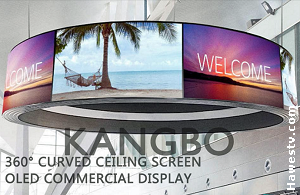
Kangbotech manufactures large, cylindrical OLED displays. These stunning displays find uses in convention exhibits. Panoramic displays like the one above are custom projects. [17.] |
About: Gould's Formulas for his 3D Television |
|
|
What was Gould's secret for recreating 3D images with mechanical television? How did this master engineer calculate the comparative speeds of his scanning drums? Here are his patented formulas, and others that the author teased out of Gould's documents. (Basic algebra!) |
GOULD 3D FORMULAS |
About: Gould's Lost Creations |
|
|
Gould was an amazingly resourceful engineer. What else did he invent? For years, the answer to this question has been lost in the U.S. patent office in Washington, D.C. After a thorough investigation, our author has unearthed more of Gould's fascinating creations. Don't miss The Lost Creations of Leslie Gould! |
GOULD'S LOST CREATIONS |
Footnotes
1. Tim Onosko, Wasn't the Future Wonderful? A View of Trends and Technology from the 1930s (New York: E.P. Dutton, 1979). •Re: Cover of Tim Onosko's book about 1930's predictions of a technical paradise. Illustrated articles from Modern Mechanics. on every page.
2. Ibid., 88. •Re: Reprint of 1931 article on Gould's 3D television system, from Modern Mechanics. Also includes portrait of Gould with his 2D mechanical television projector.
3. Ibid., 184. •Re: Author Onosko's criticism of Gould's television system (as Modern Mechanics depicted system). Doubts that Gould 3D would have worked.
4.
Leslie A. Gould, Television Receiving Apparatus [Projector patent, Type 1]
U.S. Patent 2,086,382 filed October 29, 1931, and issued July 6, 1937, 3-4.
https://patents.google.com/patent/US2086382A/en?oq=U.S.+patent+2%2c086%2c382
•Re: Displaying two-color pictures on monitor requires two-color broadcast. Patent is for
Gould's 2D, large-screen color television projector & direct-view monitor:
“Type 1” refers to Gould's 1931 patent on television with gas column tubes
& enlarged screen. (As vs. flat-plate neon tubes, typical in art of 1928 through 1934).
Type-1 monitors provide projected or direct-view pictures.
5. Ronald M. Benrey, “Add-On Converter Turns Your B&W Set Into a Color Set,” Popular Science, December, 1971, 46. •Re: Many engineers produced versions of color television with only two, instead of three primary colors. One of these versions was Spectrac: Sensation at Summer Consumer Electronics Show in 1971. This page explains how Spectrac worked. Article compares Spectrac picture to pictures on conventional, three-color television.
6. Leslie Solomon, “Simplified Mexican Color TV,” Electronics World, July, 1964, 48, 71. •Re: Description of Camarena's color television system using two primary colors. Successful tests over station XHGC in Mexico.
7. Hamamatsu Photonics K.K. Editorial Committee, Photomultiplier Tubes: Basics and Applications, 4th ed.,(Hamamatsu, Shizuoka Prefecture, Japan: Hamamatsu Photonics KK, Electron Tube Division, 2017), 17-20. •Re: Dynodes (secondary electron multipliers), feature of photomultiplier tubes (PMTs).
8. Ralph Engstrom (uncredited), RCA Photomultiplier Manual: Theory, Design, Application, Technical Series PT-61, (Harrison, NJ: RCA Electronic Components, 1970), 3-6, 174-181. •Re: Background on photomultiplier tubes (PMTs) & dynodes, pp. 3-6. External pins connect dynodes (secondary electron multipliers) to circuitry outside PMT envelope.
9.
Tomohiro Yendo, Naoki Kawakami, & Susumu Tachi, Seelinder: The Cylindrical Lightfield
Display, (access on November 23, 2021),
https://history.siggraph.org/experience/seelinder-the-cylindrical-lightfield-display-by-yendo-kawakami-and-tachi
•Re: Seelinder display, which strongly resembles the Gould 3D monitor. The
article appears on Web site of ACMSiggraph Information and Artifacts History, by Association for Computing
Machinery.
10. Ibid., •Re: Concentric drums inside the Seelinder display: (1) Parallax barrier & (2) scanning LED arrays. Analogous to Gould's (1) slot drum and (2) scanning neon tubes.
11. Ibid., •Re: Like Gould display, Seelinder display is autostereographic. But unlike Gould display, Seelinder can only display still graphics.
12. Ibid., •Re: (Graphic.) Photo of Seelinder display.
13.
Sony, Sony Hologram Prototype! (360 Degree Display),
(access on December 28, 2021),
https://youtu.be/yWigiSv16BA
•Re: Sony RayModeler monitor & camera that reproduce
pictures in walkaround 3D. Depicts both Sony 3D monitor & 3D
still camera. RayModeler technology is electromechanical, like
Gould's creations. Monitor scanning drum spins at 1,800 rpm. At
time of video, Sony camera couldn't record motion pictures of
live subjects. Motion animations were then possible. At monitor,
hand-tracking was also working. Monitor could reproduce motion
cartoons or live-action stills. Camera requires eight cameras
around a turntable “stage” area. Monitor demonstration
by Joe Kajiura. System was on exhibit in London: National History
Museum, British Library (Growing Knowledge exhibit).
14.
R. Lawler, Sony's 360-degree RayModeler 3D display brings its glasses-free act to LA, plays Breakout (video),
EnGadget, (access on December 29, 2021),
https://www.engadget.com/2010-07-28-sonys-360-degree-raymodeler-3d-display-brings-its-glasses-free.html
•Re: RayModeler at U.S. Siggraph exposition in 2010. Siggraph exhibit presented
version of Breakout game that was playable in 3D on RayModeler.
Demonstration included explanation of turntable capture system with eight cameras.
Each camera picked up 45 degrees of the 360-degree, 3D image. Company Core77
produced Breakout game for exhibit.
15.
Sony, Sony Hologram Prototype! (360 Degree Display),
(access on December 28, 2021),
https://youtu.be/yWigiSv16BA
•Re: (Graphic.) Model sitting on turntable of cylindrical camera for Sony
RayModeler.
16.
Kangbotech, OLED Screen: Flexible Curved OLED Screen Project OLED Column,
(access on November 25, 2021),
https://www.kangbotech.com/blog/flexible-curved-oled-screen-project-oled-column_b18
•Re: Cylindrical OLED video screen by Kangbotech (Kangbo Technology Co., Ltd in Tangxia,
Dongguan, China). Company designs & builds LCD & OLED displays, both for commercial &
business markets. Products include 55-inch cylindrical video screen for 360-degree exhibits.
Information: sales@kangbotech.com
More details about cylindrical screen...
https://www.kangbotech.com/55-inch-curved-flexible-oled-screen-cylinder-splicing-oled-display-for-transportations-exhibitions_p33.html
17.
Kangbotech, PRODUCTS: 55 Inch Curved OLED Flexible Ceiling OLED Spliced Screen
Display For Airport", (access on January 5, 2022),
https://www.kangbotech.com/55-inch-curved-flexible-oled-screen-cylinder-splicing-oled-display-for-transportations-exhibitions_p33.html
Go to Page: 1 2 3 4 5 6 7 8 9 Next
GOULD 3D TELEVISION
GOULD 3D FORMULAS
GOULD'S LOST CREATIONS
GET A WHEEL
Page Directory
On this page...Gould 3D: Could it Work? Gould's Footsteps Electronic Version of Gould 3D About: Gould's Formulas for his 3D Television About: Gould's Lost Creations Footnotes
On related pages...
What is Two-Color TV? Col-R-Tel vs. Spectrac Two-Color TV History TV System Flicker Comparison 2.5-Color TV Gould Television: 3D from the Great Depression Gould 3D: Camera & Monitor Formulas The Lost Creations of Leslie Gould Spectrac: Color for a Monochrome World